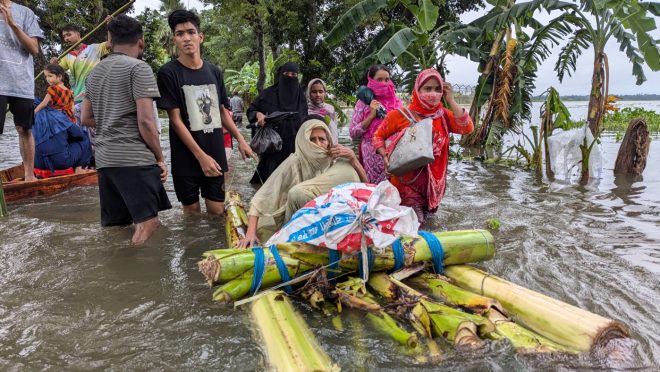What is really causing the floods?
What is really causing the floods?

Just two months after a severe flood in the northeastern region, Bangladesh is now experiencing another flood, this time in the Southern region. It started suddenly at midnight on Wednesday, 21 August. The situation has worsened in Feni, Noakhali, and Cumilla.
India has opened Dumbur dam of Gumti River in Tripura after 31 years due to heavy rains. Many have identified this to be the reason for the flooding in Bangladesh. The Business Standard spoke to two climate and water resources experts to understand what is really causing the floods.
‘The Met office knew about the rain but did not warn us’
– Dr Ainun Nishat, Professor Emeritus, Centre for Climate Change and Environmental Research (C3ER), BRAC University

Firstly, there is a misconception in the local media about dams and embankments, which is creating confusion. Dams are not ‘badh’. Dams are placed across the river to create a reservoir, while embankments, which are ‘badh’, prevent water from overflowing.
In India there is a dam on Gomti river and we also have a dam over Kaptai in Chittagong. The dams are filled as soon as monsoon begins, as the higher the amount of water stored means a higher amount of electricity produced. But by the end of monsoon, if it rains, they can no longer hold back the water.
This dam has been used to produce hydropower and prevent flooding as well. That is why there were no floods in the downstream area of Tripura and Cumilla for a while. There has not been any floods in Cumilla for around 30 years.
Secondly, the dam is on the Gomti river basin, which means, flooding cannot happen in Feni, Noakhali or Chittagong hill tracts because of it. I read in yesterday’s newspaper that it has rained around 300mm in these areas and Tripura. The reason behind this rain is depression in the Bay of Bengal. This is natural.
It is also raining heavily in Delhi. This has no relevance to us, but I am raising this topic to discuss the fact that The India Meteorological Department (IMD) issued an orange alert predicting the possibility of heavy precipitation there. Red alert has been declared in Tripura.
Here the local Meteorological Department has gotten the same info. They knew about the rain through their radar. But we were not warned. If we were warned even one day earlier, we could have prepared ourselves.
The Meteorological Department needs to be modernised. We have been saying the same thing over and over again for the last 50 years.
In the last 30 years there has not been much flooding in the Gomti basin. People have forgotten about the flood controlling embankments there, and I won’t be surprised if cracks have developed in the embankments with some much water coming in.
People’s houses have been flooded, roads have been flooded and crops have gone under water, which is saddening, however the height of water is not high. The Gomti river has gone 1-2 feet over the danger limit. If the embankments were working, the current situation would not have arisen. Every monsoon all embankments need to be checked to see if they are still capable of preventing flooding. Flooding in August is very normal.
The adviser to the interim government of Bangladesh and as Minister of Environment, Forest and Climate Change Syeda Rizwana Hasan is an expert on these matters professionally. She has just taken office so there is little she could have done. The Water ministry, Meteorological Department, and local government should be held accountable. The engineers have not been changed, what have they done?
Dr Ainun Nishat spoke to TBS Staff Feature Writer Ariful Hasan Shuvo over the phone.
‘We also need to pay attention to our own shortcomings’
– Gawher Nayeem Wahra, Climate change and disaster management expert

India should have given prior notice about opening the dams. We saw a similar situation before in Dinajpur, where they informed the Deputy Commissioner that they would open the dam due to excessive rainfall. But this time they didn’t do that.
Also, in the first place, they cannot build a barrage over a common river. We should raise this issue with the United Nations.
However, that’s one aspect, but it’s not the only reason for the current flooding. We also need to pay attention to our own shortcomings to ensure that our preventive measures are well-prepared.
Before releasing the water, it had rained. In fact, the possibility of this rain and flooding was evident almost 10 days ago. However, no forecast was issued by the Meteorological Department. It is a primary responsibility of the Meteorological Department to warn people, and there should be accountability for why that was not done.
The current generation in Feni and those other places has not witnessed such a flood before. It was crucial to alert them and inform them about ways to handle the situation. The drainage system there has collapsed.
We also need to pay attention to our infrastructure as well. We should map out the river’s flow and identify areas to avoid building houses or infrastructure along those paths, so that the water is not obstructed.
The biggest challenge right now is to maintain communication systems. People are unable to speak with their relatives. During a disaster, the role of mobile operators is often not visible. They should provide affected people with access to battery support and ensure uninterrupted network services. Rescue operations should be streamlined. I think now, all the fire brigades in the affected areas should be deployed. Special arrangements should be made to rescue children.”
Gawher Nayeem Wahra spoke to TBS Staff Feature Writer Ariful Hasan Shuvo over the phone.


